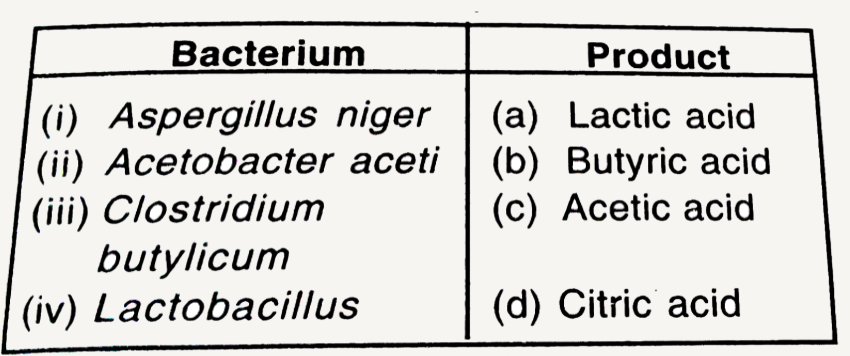Match the following list of bacteria and their commercially important products.
BacteriumProduct(i)Aspergillus niger(A)Lactic acid(ii)Acetobacter aceti(B)Butyric acid(iii)Clostridium butylicum(C)Acetic acid(iv)Lactobacillus(D)Citric acid
Choose the correct match.
ABCD2341
ABCD2431
ABCD4321
ABCD4132
The correct Answer is:C
To solve the question of matching bacteria with their commercially important products, we will analyze each bacterium and its corresponding product step by step.
1. Identify the first bacterium: Aspergillus niger
- Aspergillus niger is known for its role in the production of citric acid. It is a fungus, not a bacterium, but it is often included in discussions about microbial fermentation products.
- Match: Aspergillus niger → (D) Citric acid
2. Identify the second bacterium: Acetobacter aceti
- Acetobacter aceti is a bacterium that is primarily involved in the production of acetic acid, which is commonly known as vinegar. The name "aceti" suggests its association with acid.
- Match: Acetobacter aceti → (C) Acetic acid
3. Identify the third bacterium: Lactobacillus
- Lactobacillus is a group of bacteria that are known for their role in fermentation processes, particularly in dairy products. They are responsible for the production of lactic acid, which is crucial in the formation of yogurt and other fermented foods.
- Match: Lactobacillus → (A) Lactic acid
4. Identify the fourth bacterium: Clostridium butylicum
- Clostridium butylicum is known for producing butyric acid, which is a short-chain fatty acid. This bacterium is involved in anaerobic fermentation processes.
- Match: Clostridium butylicum → (B) Butyric acid
Summary of Matches:
- (i) Aspergillus niger → (D) Citric acid
- (ii) Acetobacter aceti → (C) Acetic acid
- (iii) Lactobacillus → (A) Lactic acid
- (iv) Clostridium butylicum → (B) Butyric acid
Final Answer:
The correct matches are:
- Aspergillus niger - Citric acid
- Acetobacter aceti - Acetic acid
- Lactobacillus - Lactic acid
- Clostridium butylicum - Butyric acid
Correct Option:
The correct option is C.
- Aspergillus niger is known for its role in the production of citric acid. It is a fungus, not a bacterium, but it is often included in discussions about microbial fermentation products.
- Match: Aspergillus niger → (D) Citric acid
- Acetobacter aceti is a bacterium that is primarily involved in the production of acetic acid, which is commonly known as vinegar. The name "aceti" suggests its association with acid.
- Match: Acetobacter aceti → (C) Acetic acid
- Lactobacillus is a group of bacteria that are known for their role in fermentation processes, particularly in dairy products. They are responsible for the production of lactic acid, which is crucial in the formation of yogurt and other fermented foods.
- Match: Lactobacillus → (A) Lactic acid
- Clostridium butylicum is known for producing butyric acid, which is a short-chain fatty acid. This bacterium is involved in anaerobic fermentation processes.
- Match: Clostridium butylicum → (B) Butyric acid
- (i) Aspergillus niger → (D) Citric acid
- (ii) Acetobacter aceti → (C) Acetic acid
- (iii) Lactobacillus → (A) Lactic acid
- (iv) Clostridium butylicum → (B) Butyric acid
The correct matches are:
- Aspergillus niger - Citric acid
- Acetobacter aceti - Acetic acid
- Lactobacillus - Lactic acid
- Clostridium butylicum - Butyric acid
The correct option is C.
Topper's Solved these Questions
- MICROBES IN HUMAN WELFARE BOOK - NCERT EXEMPLAR ENGLISHCHAPTER - MICROBES IN HUMAN WELFARE EXERCISE - Very Short Answer Type Questions
20 Videos
- MICROBES IN HUMAN WELFARE BOOK - NCERT EXEMPLAR ENGLISHCHAPTER - MICROBES IN HUMAN WELFARE EXERCISE - Short Answer Type Questions
14 Videos
- HUMAN REPRODUCTION BOOK - NCERT EXEMPLAR ENGLISHCHAPTER - HUMAN REPRODUCTION EXERCISE - LONG ANSWER TYPE QUESTIONS
5 Videos
- MOLECULAR BASIS INHERITANCE BOOK - NCERT EXEMPLAR ENGLISHCHAPTER - MOLECULAR BASIS INHERITANCE EXERCISE - Long Answer Type Questions
9 Videos
Similar Questions
Match the following list of bacteria and their commercially important products
Choose the correct match

View SolutionMatch the following organisms with the products they produce: (a) Lactobacillus(i) Cheese(b) Saccharomyces cerevisiae(ii) Curd(c) Aspergillus niger(iii) Citric Acid(d) Acetobacter acetic(iv) Bread(v) Acetic Acid
View SolutionMatch column I with column II and select the correct option from the given codes
Column IColumn IIA.Aspergilius niger(i)EthanolB.Clostridium butylicm(ii)StatinsC.Saccharomyces cerevisiae(iii)Citric acidD.Trichoderma polysporum(iv)Butyric acidE.Monascus purpureus(v)Cyclosporin A
View SolutionMatch with reference to corpora adiposa of Periplaneta and find the correct option
III(a)Trophocytes(i)Contain symbiotic bacteria(b)Mycetocytes(ii)Store food(c)Oenocytes(iii)Store uric acid(d)Urate cells(iv)Synthesise and store lipids
View SolutionIdentify the blank spaces A,B,C and D in the following table and select the correct answer.
Type of microbeScientific nameCommercial productBacteriumAStreptokinaseBAspergillus nigerCitric acidFungusTrichonderma polysporumCBacteriumDButyric acid
View SolutionMatch column I with column II and select the correct answer from the gives codes.
ColumnIColumnIIA.Trichoderma(i)Free living nitrogen fixing bacteriaB.Streptomyces(ii)Biocontrol agentC.Azospirillum(iii)Lactic acidD.Lactobacillus(iv)Source of antibiotic
View SolutionMatch the animals given in column A with their location in column B.
Column AColumn B(i)DodoA.Africa(ii)QuaggaB.Russia(iii)ThylacineC.Mauritius(iv)Stellar's sea cowD.Australia
Choose the correct match from the following.
(a) i-A, ii-C, iii-B, iv-D
(b) i-D, ii-C, iii-A, iv-B
(c) i-C, ii-A, iii-B, iv-D
(d) i-C, ii-A, iii-D, iv-B
View SolutionMatch Column - I with Column - II and select the correct option using the codes given below :
Column-IColumn-IIa.Citric acid(i)Trichodermab.Cyclosporin A(ii)Clostridumc.Statins(iii)Aspergillusd.Butyric acid(iv)Monascus
View SolutionMatch the following and choose the correct combination from the option given
Columa IColumn II(Organic Compound)(Example)A. Fatty acid1. Glutamic acidB. Phospholipid2. TryptophanC. Aromatic amino acid3. LecithinD. Acidic amino4. Palmitic acid
View SolutionMatch the items of column I and column II
Column IColumn IIa Auxinp GA3b Gebberellinsq Indole Acetic Acidc Cytokininr Abscisic Acidd Dormins Acetic acidt Zeatin
View Solution
